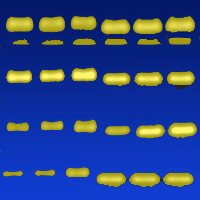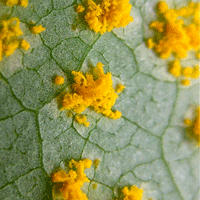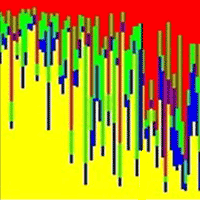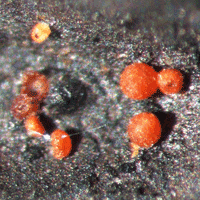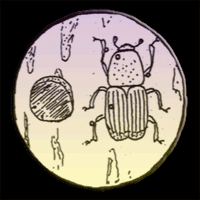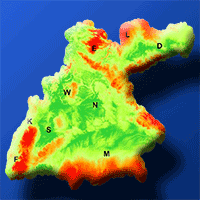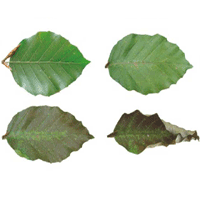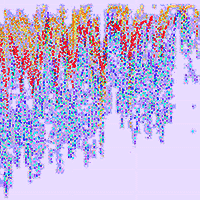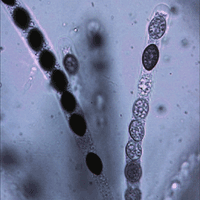
Latent infection of Biscogniauxia nummularia in Fagus sylvatica: a possible bioindicator of beech health conditions
Nicola Luchi (1) , Paolo Capretti (2), Matteo Feducci (2), Andrea Vannini (3), Barbara Ceccarelli (3), Anna Maria Vettraino (3)
iForest - Biogeosciences and Forestry, Volume 9, Issue 1, Pages 49-54 (2015)
doi: https://doi.org/10.3832/ifor1436-008
Published: Jun 18, 2015 - Copyright © 2015 SISEF
Research Articles
Abstract
Biscogniauxia nummularia is a xylariaceous fungus known as a common endophyte of European beech, living in plant tissues without development of symptoms, or even inducing strip-cankers and wood decay on trees stressed by drought. We studied the presence of the fungus in apparently healthy beech trees, growing in two different bioclimatic zones characterized by Continental and Mediterranean climates. Asymptomatic twigs were collected in each zone over the season and evaluated for the presence of B. nummularia infections using both cultural and qPCR methods. Results from qPCR indicated differences in the detection of B. nummularia among the seasons and between the study sites. In both sites the highest frequency of detection was in summer. B. nummularia was more frequently detected in the Mediterranean bioclimatic area, where drought is more common. These results suggest that B. nummularia may be a possible bioindicator of beech health stands.
Keywords
Fagus sylvatica, Latent Pathogen, Real Time PCR, Xylariaceae
Authors’ Info
Authors’ address
National Research Council - Institute for Sustainable Plant Protection, (CNR-IPSP), Via Madonna del Piano 10, I- 50019 - Sesto Fiorentino, Firenze (Italy)
Matteo Feducci
Department of Agrifood Production and Environmental Sciences, University of Florence (DISPAA). Piazzale delle Cascine, 28, I-50144, Firenze (Italy)
Barbara Ceccarelli
Anna Maria Vettraino
Department for Innovation in Biological, Agro-food and Forest Systems, University of Tuscia (DIBAF), Via San Camillo De Lellis, I- 01100, Viterbo (Italy)
Corresponding author
Paper Info
Citation
Luchi N, Capretti P, Feducci M, Vannini A, Ceccarelli B, Vettraino AM (2015). Latent infection of Biscogniauxia nummularia in Fagus sylvatica: a possible bioindicator of beech health conditions. iForest 9: 49-54. - doi: 10.3832/ifor1436-008
Academic Editor
Elena Paoletti
Paper history
Received: Aug 29, 2014
Accepted: Mar 05, 2015
First online: Jun 18, 2015
Publication Date: Feb 21, 2016
Publication Time: 3.50 months
Copyright Information
© SISEF - The Italian Society of Silviculture and Forest Ecology 2015
Open Access
This article is distributed under the terms of the Creative Commons Attribution-Non Commercial 4.0 International (https://creativecommons.org/licenses/by-nc/4.0/), which permits unrestricted use, distribution, and reproduction in any medium, provided you give appropriate credit to the original author(s) and the source, provide a link to the Creative Commons license, and indicate if changes were made.
Web Metrics
Breakdown by View Type
Article Usage
Total Article Views: 54060
(from publication date up to now)
Breakdown by View Type
HTML Page Views: 43928
Abstract Page Views: 4326
PDF Downloads: 4149
Citation/Reference Downloads: 72
XML Downloads: 1585
Web Metrics
Days since publication: 3841
Overall contacts: 54060
Avg. contacts per week: 98.52
Citation Metrics
Article Citations
Article citations are based on data periodically collected from the Clarivate Web of Science web site
(last update: Mar 2025)
Total number of cites (since 2016): 20
Average cites per year: 2.00
Publication Metrics
by Dimensions ©
Articles citing this article
List of the papers citing this article based on CrossRef Cited-by.
References
Endophytic fungi in Norway spruce - possible use in bioindicator of vitality. Aquilo Serier Botanicae 19: 228-232.
Gscholar
Impact, control and management of Heterobasidion annosum. Italy. In: “Heterobasidion annosum: Biology, Ecology, Impact and Control” (Woodward S, Stenlid J, Karjalainen R, Hüttermann A eds). CAB International, Wallingford, UK, pp. 377-385.
Gscholar
Fenomeni di deperimento e di moria in popolamenti artificiali misti di latifoglie e conifere [Decay and blight phenomena in mixed artificial populations of broadleaves and conifers]. Annali Accademia Italiana di Scienze Forestali 52: 3-30. [in Italian]
Gscholar
Root rot disease by Heterobasidion annosum on Fagus sylvatica stands in southern Italy. Journal of Plant Pathology 89: 34-34.
Gscholar
Detection, identification and quantification of latent needlecast pathogens and endophytee in symptomless conifer foliage by PCR and Dot-Blot assays. In: Proceedings of the “IUFRO Working Party 7.02.02 - Shoot and Foliage Diseases”. Hyytiala (Finland) 17-22 Jun 2001. Finnish Forest Research Institute Research Papers, Joensuu, Finland, vol. 829, pp. 164-168.
Gscholar
Structure and diversity of “pathogenic” and “non-pathogenic” fungal endophyte community of Fagus sylvatica in the Mediterranean Basin. Ph.D. Thesis, Università degli Studi della Tuscia, Viterbo, Italy, pp. 101.
Gscholar
Tests for departure from normality. Empirical results for the distributions of b2 and √b1. Biometrika 60: 613-622.
Gscholar
Observation on the beech woodlands of the Apennines (peninsular Italy): an intricate biogeographical and syntaxonomical issue. Lazaroa 30: 89-97.
Gscholar
Ruolo dei parametri ambientali e di Biscogniauxia nummularia nella formazione di necromassa in un ceduo di faggio dell’Appenino Pistoiese. [Role of environmental parameters and Biscogniauxia nummularia in the formation of deadwood in a beech coppice in the Apennines (Pistoia)]. M.Sc. thesis in Environmental and Forest Science, University of Florence, Italy, pp. 37.
Gscholar
Decline of beech associated to Biscogniauxia nummularia in Italy. Petria 4: 111-116.
Gscholar
The climate environment of the “CASCADE” sites. EU Project EVK2-CT-1999-00006 II Report, CNRS-CEFE, Montpellier, France, pp. 70.
Gscholar
Climate change 2007: impacts, adaptation and vulnerability. Contribution of working group II to the fourth assessment report of the intergovernmental panel on climate change (Parry ML, Canziani OF, Palutikof JP, Van Der Linden PJ, Hanson CE eds). Cambridge University Press, Cambridge, UK, pp. 976.
Gscholar
Epiphytic lichens as biomonitors of atmospheric pollution in Slovenian forests. Environmental Pollution. 146: 324-331.
Gscholar
Reperti di B. nummularia su faggio in Italia. [Biscogniauxia nummularia on beech in Italy]. Micologia Italiana 1: 27-35. [in Italian]
Gscholar
I boschi d’Italia [Italian woods]. UTET, Torino, Italy, pp. 667. [in Italian]
Gscholar
Symptoms as bioindicators of decline in European forests. In: “Committee on Biologic Markers of Air-Pollution Damage in Trees”. National Research Council, National Academy Press, Washington DC, USA, pp. 119-124.
Gscholar
Impacts of climate change on biodiversity, ecosystems, and ecosystem services: technical input to the 2013 National climate assessment. Cooperative Report to the 2013 National Climate Assessment, Palo Alto, CA, USA, pp. 296.
Online | Gscholar
Armillaria mellea and mortality of beech affected by beech bark disease. In: Proceedings of the “IUFRO Beech Bark Disease Working Party Conference”. Hamden (CT, USA) Sep 26-Oct 8 1982. Gen. Tech. Rep. WO-37, Northeastern Forest Experiment Station, USDA Forest Service, Washington, DC, USA, pp. 81-88.
Online | Gscholar

